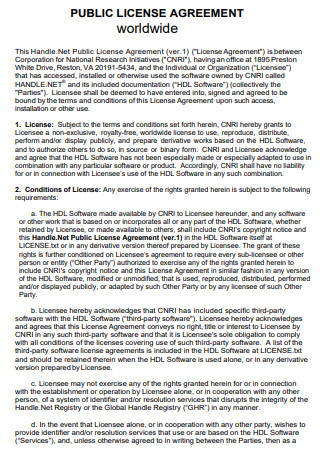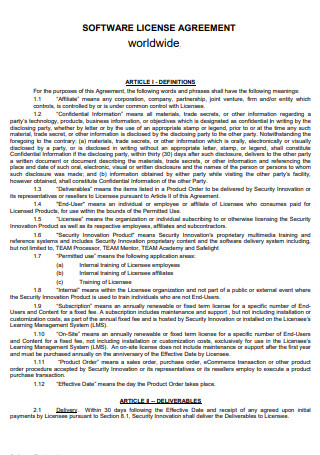22+ SAMPLE Worldwide License Agreement
-

Worldwide License Agreement
download now -

Sample Worldwide License Agreement
download now -

Worldwide Copyright License Agreement
download now -

Worldwide Trademark License Agreement
download now -

Public Worldwide License Agreement
download now -

Worldwide Film License Agreement
download now -

Simple Worldwide License Agreement
download now -

Worldwide License Grant Agreement
download now -

Worldwide License Contributor Agreement
download now -

Free Worldwide License Agreement
download now -

Worldwide End User License Agreement
download now -

Worldwide Data License Agreement
download now -

Basic Worldwide License Agreement
download now -

Worldwide Content License Agreement
download now -

General Worldwide License Agreement
download now -

Worldwide Software License Agreement
download now -

Worldwide License Agreement Example
download now -

Worldwide Distribution License Agreement
download now -

Worldwide Enterprise License Agreement
download now -

Worldwide License Agreement Template
download now -

Worldwide License Program Agreement
download now -

Worldwide Non-Profit License Agreement
download now -

Standard Worldwide License Agreement
download now
FREE Worldwide License Agreement s to Download
22+ SAMPLE Worldwide License Agreement
What Is a Worldwide License Agreement?
Benefits of Licensing
Tips for Common Intellectual Property Issues
How to Protect Your Business
FAQs
What is an example of a licensing agreement?
Is the license agreement legal?
How do license agreements protect users?
What Is a Worldwide License Agreement?
Several agreements are signed with a third party or third-party affiliates in countries as part of a worldwide license arrangement. With this arrangement, a company is permitted to use the protected designs, patents, trademarks, and other intellectual property of another company. A worldwide license agreement includes the terms and restrictions the licensee must adhere to continue using the protected materials.
Benefits of Licensing
A licensing agreement grants the licensee the right to utilize a product previously owned by the licensor. A license agreement might include a variety of assets, including a trademark, a patent, and even branding. The license agreement outlines the licensee’s rights, which may be able to sell products, use a trademark, or capitalize on a particular brand message. The licensee is permitted to retain the profits earned through licensed merchandise. In exchange for continued usage of their things, the licensor receives an agreed-upon royalty from the earnings generated. Most licensing agreements require an upfront, one-time payment to access the requested items. When signing a contract, all parties should examine the licensing benefits.
Tips for Common Intellectual Property Issues
Intellectual property rights are your ownership rights over the things you make with your creative thoughts. If your creation has economic value, you will want to learn how to safeguard your intellectual property (IP) from anyone using it for their benefit. We examine several of the most common errors made about intellectual property rights. Here are some practical suggestions to avoid falling into these pitfalls.
1. Not Structuring Correctly
Too frequently, we see entrepreneurs with fantastic ideas, exceptional brands, and special procedures fail at the initial obstacle. Tax arrears or third-party lawsuits can quickly destroy a startup corporation. By constructing correctly, start with the end in mind. Through correct structuring, intellectual property can be shielded from trade risks, counterparty risks, and other general risks. The classic example of proper structure is the employment of intellectual property holding trusts or corporations to have all of the brand, goodwill, and copyright material constituting the business system that is the core asset of a franchise business. This intellectual property is then licensed to master franchisees and franchisees. The license agreement stipulates that the license will end automatically upon the insolvency of any licensee. As the insolvent licensee no longer possesses intellectual property rights, neither does the administrator or liquidator assume the licensee’s position. This organizational style protects this intellectual property from the day-to-day business and liability issues that the master franchisor faces.
2. Co-ownership Risk
Using intellectual property jointly with another party, particularly in developing new products, can carry considerable unexpected dangers and repercussions. Ensure you have a documented agreement covering ownership and usage of intellectual property with the other party. When you combine your valuable intellectual property with that of a third party or when a third party supports you in creating your intellectual property, both parties may jointly hold the resulting intellectual property. This may have been different from the intention of the parties. This can be accomplished by working on a project where each side contributes their knowledge, time, and other resources. Even if a participant may have committed intellectual property that is individually held, the end product is intellectual property that is jointly owned. In such a case, both parties can only exploit the intellectual property with the other’s authorization. This could lead to costly litigation to remedy the issue. Where it is intended that you retain ownership of some or all of the intellectual property, this should be clearly stated in a written agreement containing the relevant articles through which the other party assigns (transfers) its rights to you.
3. Not Registering Your Brand
Many facets of intellectual property can be safeguarded through official registration. For example, brand identification can be protected by registering logos, marketing words, and other distinctive designs that identify you or your products. This registration operates on a “first-come, first-served” basis. Therefore the first to register will have priority over later applications for similar trademarks. A trademark-experienced attorney can provide support, advice, and direction in taking the essential steps to get trademark protection.
4. Not Ensuring That Copyright Documents Are Adequately Protected
Copyright material is automatically protected by law for the author of an original work, although it is nevertheless preferable to avoid conflicts if feasible. Always be explicit about the ownership of your work. The Copyright Act of 1968 immediately grants copyright to every original work you produce. Yet, it is advantageous to ensure that third parties are aware that the content is yours, as preventing a copyright infringement is preferable (and much less expensive) than enforcing your rights in court.
How to Protect Your Business
As a newly established small business owner, everything is fresh and exciting. Nonetheless, it is simple to overlook the hazards associated with business ownership. In addition, learning the proper work procedures might be time-consuming, but you need to do so to ensure your success. A significant number of small businesses need to plan for substantial risks that could cause problems in the future. To avoid this, you may future-proof your small business from the start with insurance. Obtaining the appropriate insurance coverage can assist in paying for claims filed against you, whether they allege bodily injury or property damage. Follow these steps to learn more about how to safeguard your small business:
1. Create a Financial Plan
The greatest financial danger of starting a firm is running out of money before establishing success. This can be avoided if you prepare ahead of the revenue growth curve. Cash flow statements are the center of practically everything you do and think as a small business owner. You’ll need a comprehensive financial strategy that details your fixed and variable costs, as well as anticipated income and expansion. This allows you to predict monthly and annual cash inflows and outflows. Also, you can use your financial plan to evaluate potential finance or fundraising requirements. This protects your ability to meet expenses until your organization generates sufficient recurring revenue. Always attempt to safeguard your possessions. Personal funds should only be used as a last resort. Putting your finances at stake increases the danger.
2. Hire an Attorney
Today, lawsuits are prevalent and pose a significant threat to business owners. In addition to being incredibly expensive, legal fees can also harm your reputation. It would help to investigate a law firm specializing in your industry to avoid legal hazards. They can offer legal counsel, assist you in navigating any legal challenges, and supervise legal transactions such as hold harmless agreements.
3. Purchase Small Company Insurance
The majority of small business owners require business insurance. These coverages can help protect your firm against claims and lawsuits. In addition, they are an excellent means of future-proofing your business operations. Additionally, company insurance can be adjusted to various operating methods and business kinds.
4. Keep Your Business’s Data Safe
Most small firms save client information forms, such as customer addresses and credit card form. For this reason, data breach insurance is essential to developing future-proof business models. This coverage can assist your organization in responding promptly to data breaches. For instance, if your organization’s systems are infected with a virus that exposes personally identifiable information, data breach insurance can assist in covering the costs associated with responding to the breach. Without this coverage, you would be responsible for these charges.
5. Keep and Guard Your Reputation
Building and maintaining your reputation is one of the essential marketing methods. Reputation is crucial in generating repeat business and attracting new clients. If your business is through a digital transformation, it is equally critical to establish a positive reputation on social media sites. Recall that solid reputations lead to long-term company success.
FAQs
What is an example of a licensing agreement?
An agreement between a firm and the copyright owners of software permitting the latter to use the computer program for regular business operations is an example of a license agreement.
Is the license agreement legal?
License agreements are contracts; hence contract law concepts are applicable. Therefore, while establishing such agreements, the parties are urged to add terms on, among other things, confidentiality and contract breach.
How do license agreements protect users?
With mobile apps and social media, license agreements are widespread. Eventually, an end-user licensing agreement protects you, the app’s owner or licensor, against copyright infringement and another software misuse. Hence it is essential to include one when distributing software to clients.
A global or international license agreement is a contract that is necessary for establishing commercial partnerships across multiple regions to have access to a broader market. It specifies which properties or materials the parties involved are authorized to utilize. This assists them in preventing or resolving potential future disputes. The contract also contains clauses regarding contract duration, dispute resolution, exclusivity, inventory checklist, sales requirements, oversight, quality control plan, and payment contracts.
